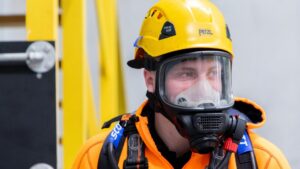For those working in high-risk environments – including at heights and in confined spaces – rescue training is just as important as being trained in performing the work itself.
The nature of completing high-risk work is that the probability of an accident can only ever be reduced – it cannot be removed entirely. And although everyone works to ensure that their colleagues and team members are kept safe while completing high-risk work, the simple fact is that accidents sometimes happen.
In those moments where a day at work has not gone according to plan, having the skills, knowledge, and equipment to quickly facilitate the rescue of a fallen, trapped or overcome co-worker could be the difference between filling out an incident report or something far worse.
Every second counts
If something has gone wrong, and a worker needs rescuing, time is of the essence. In the event of a fall, it can be a matter of minutes before a worker hanging in their harness can start experiencing the consequences of suspension trauma.
Even if the emergency services are called immediately, that six to seven minutes could be too long. For those in more remote or regional areas, response times from emergency services are commonly much longer.
In the event of a worker hanging from a harness after a fall, the risks of suspension trauma become increasingly real after just 10 minutes, according to the Australian Resuscitation Council.
A lack of movement of the legs leads to the pooling of blood in the lower extremities. As the heart struggles to get oxygenated blood around the rest of the body, a loss of consciousness can come quickly, leading to other problems including cardiac arrest (heart attack).
Similar issues can exist for workers in confined spaces, if they are overcome by an irrespirable atmosphere – either through the depletion of oxygen, or another hazardous gas displacing the oxygen.
The longer a worker is left unconscious, the greater the risk of significant complications for their health.
Being able to quickly respond to a workplace accident and recover an incapacitated worker quickly, and initiate first aid and CPR response, can be vital to increasing the chances of a better recovery.
Workers know their site better than anyone
Another advantage that workers on a site have when it comes to quickly undertaking a rescue, is they understand what is on site, where additional risks are. They may also be able to determine what structures could be utilised as effective anchor points for rescuers or extraction points for a casualty.
Additionally, this understanding could be channeled into an updated emergency plan before the accident takes place. This would then allow the entire team to be made aware of what resources exist on the site itself to assist in the event of an accident.
Responsibilities under the law
Having rescue and emergency procedures in place is a requirement by law. The Work Health and Safety Regulation 2017 (in NSW) requires that a PCBU “ensure that an emergency plan is prepared for the workplace”. The emergency plan must provide for emergency procedures, including an effective response to an emergency, the testing of those procedures as well as “information, training and instruction to relevant workers in relation to implementing the emergency procedures”.
Long story short, what this says is that PCBUs need to have a plan for when something goes wrong, and people equipped to action that plan. For workers in high-risk environments this really means having rescue plans and being able to perform them.
Get trained with your partners in protecting people
You can discuss your site safety and emergency plan needs with our team of experts, whether you need rescue training or another course from our broad scope. Call us on 1300 884 978 or email enquiries@heightsafety.net to get started on your safety journey.





